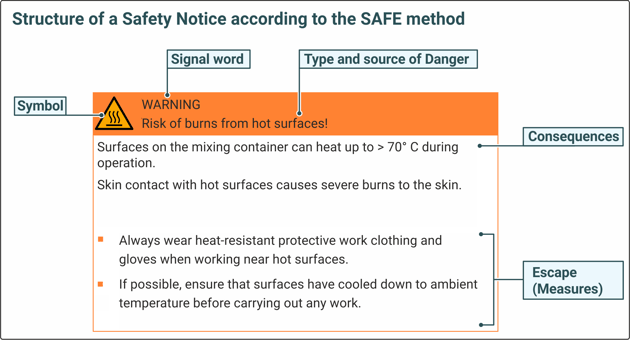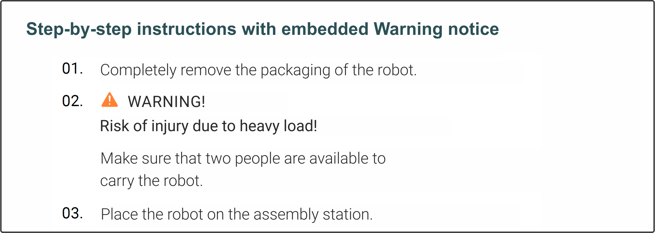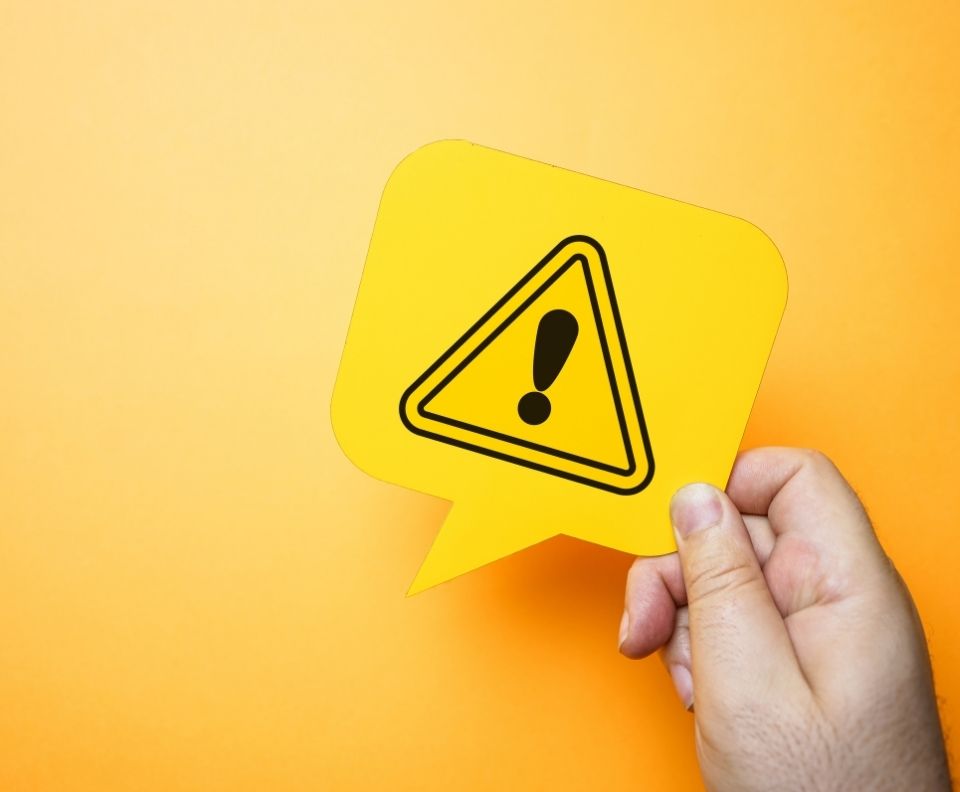Safety Instructions and Warnings are a central aspect in the world of technical documentation.
The question of their correct use is always real issue and is still hotly debated – not only among Technical Editors. In our everyday technical editorial work, we often encounter the same uncertainties with manufacturers: How do I structure a Notice correctly? What are the design requirements and what is the best way to place the instructions in the manual?
We've summarised the key points for you, and we explain in this article what's important.
A brief digression: Why is safety-related information so important in technical documentation?
Machine safety is the basis for safe cooperation between humans and machines.
For manufacturers, this means that they must design their machines and systems to be as safe as possible (i.e. the health and accident risk they pose must be minimised by design or by protective measures). This is not always 100% possible – in such cases, unavoidable residual risks remain even after all design options have been exhausted. These are risks that arise solely from the expected and intended use of the product and for this reason cannot simply be "designed away".
This is where the statutory obligation to provide instructions comes into play. It states: Manufacturers must clearly identify such unavoidable hazards in the form of safety-related information in the technical documentation for a product and describe in detail the measures required to avoid the hazard.
What safety-related information already exists?
Everyone knows them: Safety Instructions and Warnings – e.g. in the instructions for a product or on the product itself. The two terms are often used synonymously, even though, strictly speaking, this isn't entirely correct. Where are the differences?
The answer can be found in one of the basic standards for technical documentation – DIN EN IEC/IEEE 82079-1:2021-09, which distinguishes between the following three types of safety-related information:
Safety Instructions
Safety Instructions must be provided at the beginning of the instructions in a separate section such as the Safety chapter. They're intended to provide a basic explanation of how to handle the product in a safe manner and to create a general safety awareness of potential hazards.
It's a good idea to sort the different types of hazards by topic for greater clarity and easier access.
Warnings
In contrast to Safety Instructions, Warnings are mentioned directly in the context within which the hazard occurs. Usually, this happens directly before or within step-by-step instructions. In the latter case, the use of so-called Embedded Warnings makes sense – but more on that later.
Safety Signs and Product Safety Labels
Safety-related information can also be placed directly on the product; for example, in the form of Product Labels.
Here it's important: The Safety Information and Signs (i.e. Pictograms) on the product must not contradict the information in the associated instructions (i.e. the manual). In the event that a label also contains text, this should be written in the target language of the specific country.
How can I structure a notice in accordance with standards?
When it comes to the structure and design of Safety and Warning Labels, many manufacturers follow the ANSI Z535.6 standard. Although this is a US standard, its specifications are internationally recognised and established. For example, some specifications in the form of DIN EN 82079-1 have also been adopted for the German/European market.
The so-called SAFE method has become established in practice for the systematic creation of Notices. Anyone who follows this method can derive the most important elements of a Safety or Warning Notice in four defined steps.
S = Set Signal Word and Symbol
Signal Word
The Signal Word indicates the severity of the hazard. DIN EN 82079-1 defines four Signal Words and the associated degree of danger as follows:

- DANGER indicates an imminently hazardous situation. If this is not avoided, death or very serious injuries will result.
- WARNING indicates a possibly imminent hazardous situation. If this is not avoided, death or serious injury will result.
- CAUTION indicates a potentially hazardous situation which, if not avoided, may result in minor or moderate injury.
- NOTICE or CAUTION indicates a situation which, if not avoided, may result in property damage to the product or other property. At this point, an additional recommendation: Risks of property damage should not be listed together with risks of injury in a Notice. In such a case, it's advisable to create a separate Notice for personal injury and property damage.
Symbol
The Danger Symbol – or more precisely the Warning Sign – is used to highlight the Notice and to specify the nature of the hazard. The design principles for Warning Signs and the associated pictograms are defined in the DIN ISO 3864 series of standards and the ISO 7010 standard.
Are you unsure which pictogram is the correct one to appropriately identify a particular hazardous situation? In such cases, the following basic rule applies: Use the pictogram with a black exclamation mark in the middle. This clearly emphasises that there is a risk of injury in the situation described.
In addition, the following applies: Notices concerning damage to property must not contain a triangular danger pictogram, as these may only be used in connection with personal injury.

A = Specify the Type and Source of the hazard (Translated from "Art und Quelle der Gefahr festlegen")
Briefly and concisely describe the source of the hazard here.
Example: "Risk of burns from hot surfaces".
F = Specify consequences of non-compliance (Translated from "Folgen bei Missachtung festlegen")
Here, name the consequences that may occur if the Notice is not followed.
Example: "Serious bodily injury".
E = Specify escape (measures to avoid the hazard). (Translated from "Entkommen (Maßnahmen zur Vermeidung der Gefahr) festlegen")
At this point, explain which measures and activities are required to prevent the previously mentioned hazards as effectively as possible.
Example: "Wear heat-resistant protective gloves."
Put the SAFE (German acronym) building blocks together to form a Notice
Thanks to the SAFE method, we were able to determine the content for our example notice in a straightforward manner. How do we now combine these individual content modules into a clearly laid out Notice? From the previously mentioned standards, it's not possible to derive a clearly defined procedure for arranging, highlighting and designing the individual elements in a special way. Basically, however, it's important:
The design of Safety and Warning Notices must be consistent (i.e. all Notices in an instruction must be clearly recognisable as such (DIN EN 82079, Chapter 7.11.5.2).
The following example shows a tried-and-true design for a Safety Notice.

Correct Warning in context: Embedded Warnings
As previously stated, Embedded Warnings are those notes that are placed directly within a step-by-step instruction. The purpose of these notes is to draw attention to an imminent hazardous situation as concisely as possible and in the correct context. The following recommendation applies to the design of Embedded Warnings in accordance with ANSI Z535.6 : In contrast to the Safety Instructions at the beginning of a manual, you should refrain from using design highlights such as boxes or lines here. . Otherwise, the note will be visually separated from the surrounding text, which can lead to readers simply skipping the "note box". Instead, use the formatting of the action sequence in which the hint is embedded as a guide.
In combination with the obligatory Warning Sign, a minor adjustment of the standard text (e.g. by using bold letters) helps to increase the attention-grabbing effect of the Notice without interrupting the reading flow.
How is an "embedded hint" structured in concrete terms?
Here, the proven SAFE method is used again – but with a small special feature when you describe the measure to avert danger (E = Escape):
As the following example shows, the measure is not part of the Notice itself, but is placed below it as an independent action step.

How should Notices be formulated?
The appropriate language and wording is what counts: What generally applies to technical documentation must logically also be observed when creating Safety and Warning Notices.
We've summarised the central formulation and language rules in the area of technical communication for you, here again:
- Simple sentence structure, simple formulations
Use clear and unambiguous wording that makes it unambiguous and easy to understand where a hazard exists. - Observe logical sequence
Put functional relationships and processes in a logical order to correctly represent the cause-and-effect principle of a hazardous situation. - Formulate actively
"The switch must be activated." Passive formulations like this leave the person acting ambiguously. Avoid such ambiguity and instead, use active wording to clearly and unambiguously prompt the reader to take action. - Standardise
Sentence structure, wording patterns, and terminology: language consistency helps readers grasp essential information more quickly and distinguish the important from the unimportant. - Avoid nouns
Unnecessary nouns inflate texts and make them difficult to understand. We recommend: Avoid so-called functional verb phrases ("make the adjustment") whenever possible and use only the appropriate verb ("adjust").
A lot helps a lot? It's better to "warn wisely"
One question on the subject of Safety Instructions and Warnings gets asked over and over:
How many Warnings should be included in a good manual? For a long time, many Technical Editors were of the opinion that it's better to warn once too often than once too seldom – according to the motto "the more warnings, the more safety". Unfortunately, for the readers of a manual, this calculation doesn't necessarily add up. In the worst case, such an approach is even counterproductive, and important information is simply overlooked among the flood of Warnings.
In the US, this is now referred to as "warning pollution".
For some years now, the technical documentation industry has therefore been increasingly concerned with warning in a sensible and systematic manner. For Technical Editors, this means: providing clear and precise instructions and warning only where it's really necessary (e.g. because the user is not expecting a danger in this situation or is not aware of the danger).
Of course, it's important to know and take into account the previous knowledge of the target audience. It will definitely not help a qualified electrician if every second action step warns of the dangers of electric shock.
In this case, it makes sense to reduce the number of Warnings to a reasonable level and not unnecessarily disrupt the reading flow.
The limitations of the SAFE method – a classification
Four simple steps to the perfect Warning, thanks to SAFE? You probably already guessed it:
We can't make it too easy for ourselves, so the question is: What exactly are the benefits and limitations of the SAFE concept in everyday technical editorial work? Let's bring some order to the chaos:
SAFE: The cheat sheet in your mind
In any case, the SAFE concept has one advantage: You can use it as a mnemonic to reliably grasp the four essential components of a warning (signal word, type of danger, possible consequences, escape / translated from the German acronym of SAFE) – very much in the sense of a checklist that you tick off so as not to forget anything important, and which helps to sensitise your team to a careful approach to the subject of Warnings.
And beyond that?
As with other formulaic techniques and mnemonic devices in the technical documentation world, the same applies here:
A rigid formalism alone doesn't create added information value for the readers of a manual. As always, it's the content that counts. The real art lies in researching this content to the necessary depth and preparing it didactically so that the target audience can act safely in a hazardous situation. This also means:
The formal structure of a Warning must match the content. A design based on the SAFE principle is not always ideal for this purpose. Depending on the product, target audience and context, alternative forms of presentation – such as structured continuous text – may work better. This is evident not least in the use of images. As is well known, they say more than a thousand words and can often illustrate a particular hazardous situation much better than mere text. However, this aspect is not taken into account at all in the SAFE method and is consequently too quickly neglected in practice if this method is strictly followed.
In addition, the SAFE principle is closely tied to traditional printed documentation. However, modern information solutions such as animations, videos or augmented reality applications are much more dynamic and can be aligned much more closely to the needs of the target audience. Especially in this context, the template-like creation and design of safety information in accordance with the SAFE model will increasingly lose its importance.
Our conclusion is therefore: Use the SAFE method as an aid to thinking in order to always have all the important elements of a Warning Notice present. However, please also note that this method is not mandatory and its use doesn't exempt you from having to deal intensively with a didactic concept for your Warnings.

